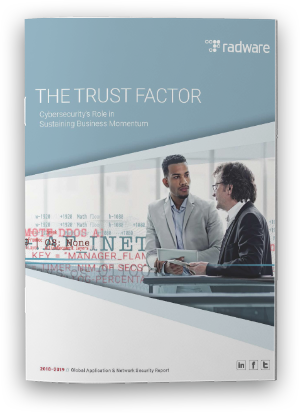Why Hybrid Always-On Protection Is Your Best Bet
Users today want more. The ubiquity and convenience of
online competition means that customers want everything better, faster, and
cheaper. One key component of the user experience is service availability.
Customers expect applications and online services to be constantly available
and responsive.

The problem, however, is that a new generation of larger and more sophisticated Distributed Denial of Service (DDoS) attacks is making DDoS protection a more challenging task than ever before. Massive IoT botnets are resulting in ever-larger volumetric DDoS attacks, while more sophisticated application-layer attacks find new ways of exhausting server resources. Above all, the ongoing shift to encrypted traffic is creating a new challenge with potent SSL DDoS floods.
Traditional DDoS defense – either premise-based or cloud-based – provide incomplete solutions which require inherent trade-offs between high-capacity volumetric protection, protection against sophisticated application-layer DDoS attacks, and handling of SSL certificates. The solution, therefore, is adopting a new hybrid DDoS protection model which combines premise-based appliances, together with an always-on cloud service.
Full Protection Requires Looking Both Ways
As DDoS attacks become more complex, organizations require more elaborate protections to mitigate such attacks. However, in order to
guarantee complete protection, many types of attacks – particularly the more sophisticated ones – require visibility into both inbound and outbound
channels.
[You may also like: DDoS Protection Requires Looking Both Ways]
Attacks such as large-file DDoS attacks, ACK floods, scanning attacks, and others exploit the outbound communication channel for attacks that cannot be identified just by looking at ingress traffic. Such attacks are executed by sending small numbers of inbound requests, which have an asymmetric and disproportionate impact either on the outbound channel, or computing resources inside the network.
SSL is Creating New Challenges
On top of that, SSL/TLS traffic encryption is adding another
layer of complexity. Within a short time, the majority of internet traffic has become encrypted. Traffic encryption helps secure customer data, and users now expect security to be part of the service experience. According to the Mozilla Foundation’s Let’s Encrypt project, nearly 80% of worldwide internet traffic is already encrypted, and the rate is constantly growing.
[You may also like: HTTPS: The Myth of Secure Encrypted Traffic Exposed]
Ironically, while SSL/TLS is critical for securing user data, it also creates significant management challenges, and exposes services to a new generation of powerful DDoS attacks:
- Increased Potency of DDoS Attacks: SSL/TLS connections requiring up to 15 times more resources from the target servers than the requesting host. This means that hackers can launch devastating attacks using only a small number of connections, and quickly overwhelm server resources using SSL floods.
- Masking of Data Payload: Moreover, encryption masks – by definition – the internal contents of traffic requests, preventing deep inspection of packets against malicious traffic. This limits the effectiveness of anti-DDoS defense layers, and the types of attacks they can detect. This is particularly true for application-layer (L7) DDoS attacks which hide under the coverage of SSL encryption.
- SSL Key Exposure: Many organizational, national, or industry regulations which forbid SSL keys from being shared with third-party entities. This creates a unique challenge to organizations who must provide the most secured user experience while also protecting their SSL keys from exposure.
- Latency and Privacy Concerns: Offloading of SSL traffic in the cloud is usually a complex and time-consuming task. Most cloud-based SSL DDoS solutions require full decryption of customer traffic by the cloud provider, thereby compromising user privacy and adding latency to customer communications.
Existing Solutions Provide Partial Coverage
The problem, however, is that existing anti-DDoS defenses
are unable to provide solutions that provide high-capacity volumetric
protection while providing bi-directional protection required by sophisticated
types of attacks.
On-Premise Appliances provide high level of
protection against a wide variety of DDoS attacks, while providing very low
latency and fast response. In addition, being on-premise, they allow companies
to deal with SSL-based attacks without exposing their encryption keys to the
outside world. Since they have visibility into both inbound and outbound
traffic, they offer bi-directional protection against symmetric DDoS attacks.
However, physical appliance can’t deal with large-scale volumetric attacks
which have become commonplace in the era of massive IoT botnets.
[You may also like: How to (Securely) Share Certificates with Your Cloud Security Provider]
Cloud-based DDoS protection services, on the other hand, possess the bandwidth to deal with large-scale volumetric attacks. However, they offer visibility only into the inbound communication channel. Thus, they have a hard time protecting against bi-directional DDoS attacks. Moreover, cloud-based SSL DDoS defenses – if the vendor has those at all – frequently require that the organization upload their SSL certificates online, increasing the risk of those keys being exposed.
The Optimal Solution: Hybrid Always-On Approach
For companies that place a high premium on the user experience, and wish to avoid even the slightest possible downtime as a result of DDoS attacks, the optimal solution is to deploy an always-on hybrid solution.
The hybrid approach to DDoS protection combines an on-premise hardware appliance with always-on cloud-based scrubbing capacity. This helps ensure that services are protected against any type of attack.
[You may also like: Application Delivery Use Cases for Cloud and On-Premise Applications]

Compared to the pure-cloud always-on deployment model, the hybrid always-on approach adds multi-layered protection against symmetric DDoS attacks which saturate the outbound pipe, and allows for maintaining SSL certificates on-premise.
Benefits of the Hybrid Always-On Model
- Multi-Layered DDoS Protection: The combination of a premise-based hardware mitigation device coupled with cloud-based scrubbing capacity offers multi-layered protection at different levels. If an attack somehow gets through the cloud protection layer, it will be stopped by the on-premise appliance.
- Constant, Uninterrupted Volumetric Protection: Since all traffic passes through a cloud-based scrubbing center at all times, the cloud-based service provides uninterrupted, ongoing protection against high-capacity volumetric DDoS attack.
- Bi-Directional DDoS Protection: While cloud-based DDoS protection services inspect only the inbound traffic channel, the addition of a premise-based appliance allows organizations to inspect the outbound channel, as well, thereby protecting themselves against two-way DDoS attacks which can saturate the outbound pipe, or otherwise require visibility to return traffic in order to identify attack patterns.
- Reduced SSL Key Exposure: Many national or industry regulations require that encryption keys not be shared with anyone else. The inclusion of a premise-based hardware appliance allows organizations to protect themselves against encrypted DDoS attacks while keeping their SSL keys in-house.
- Decreased Latency for Encrypted Traffic: SSL offloading in the cloud is frequently a complex and time-consuming affair, which adds much latency to user communications. Since inspection of SSL traffic in the hybrid always-on model is done primarily by the on-premise hardware appliance, users enjoy faster response times and lower latency.
Guaranteeing service availability while simultaneously ensuring the quality of the customer experience is a multi-faceted and complex proposition. Organizations are challenged by growth in the size of DDoS attacks, the increase in sophistication of application-layer DDoS attacks, and the challenges brought about by the shift to SSL encryption.
Deploying a hybrid always-on solution allows for both inbound and outbound visibility into traffic, enhanced protections for application-layer and encrypted traffic, and allows for SSL keys to be kept in-house, without exposing them to the outside.

Read “The Trust Factor: Cybersecurity’s Role in Sustaining Business Momentum” to learn more.
Eyal Arazi
Eyal is a Product Marketing Manager in Radware’s security group, responsible for the company’s line of cloud security products, including Cloud WAF, Cloud DDoS, and Cloud Malware Protection. Eyal has extensive background in security, having served in the Israel Defense Force (IDF) at an elite technological unit. Prior to joining Radware, Eyal worked in Product Management and Product Marketing roles at a number of companies in the enterprise computing and security space, both on the small scale startup side, as well as large-scale corporate end, affording him a wide view of the industry. Eyal holds a BA in Management from the Interdisciplinary Center (IDC) Herzliya and a MBA from the UCLA Anderson School of Management.
*** This is a Security Bloggers Network syndicated blog from Radware Blog authored by Eyal Arazi. Read the original post at: https://blog.radware.com/security/2019/06/why-hybrid-always-on-protection-is-your-best-bet/




